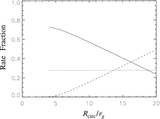Tidal Disruptions of Main-sequence Stars. V. The Varieties of Disruptions
Abstract
Tidal disruption events (TDEs) are generally imagined as the complete disruption of a star when it passes close to a supermassive black hole (SMBH). Relativistic apsidal precession is thought to quickly "circularize" the bound debris, forming a compact accretion disk, which then emits a flare of standardized light curve and spectrum. We show here that this picture holds in only a minority of cases. TDEs are more diverse and can be grouped into several categories distinguished by stellar pericenter distance rp; we estimate the relative frequency of these categories. Rapid circularization is rare both because it requires ${r}_{p}\leqslant {R}_{\mathrm{circ}}\sim 10{r}_{g}$ ( ${r}_{g}\equiv {{GM}}_{\mathrm{BH}}/{c}^{2}$ ) and because most events with ${r}_{p}\leqslant 14{r}_{g}$ lead to direct capture. For larger pericenter distances, ${R}_{\mathrm{circ}}\lt {r}_{p}\lt 27{r}_{g}$ (for MBH = 106 M⊙), main-sequence stars with M* ≲ 3 are completely disrupted, but the bound debris orbits are highly eccentric and possess semimajor axes ∼100× the scale of the expected compact disk. Partial disruptions with fractional mass loss ≳10% occur with a rate similar to that of total disruptions; for fractional mass loss ≳50%, the rate is ≈1/3 as large. Partial disruptions—which must precede total disruptions when the stars' angular momenta evolve in the "empty loss-cone" regime—change the orbital energy by factors ≳O(1). Partial disruption remnants are in general far from thermal equilibrium. Depending on its orbital energy and conditions within the stellar cluster surrounding the SMBH, a remnant may return after ∼O(100)-O(1000) yr and be fully disrupted, or it may rejoin the stellar cluster.
- Publication:
-
The Astrophysical Journal
- Pub Date:
- November 2020
- DOI:
- 10.3847/1538-4357/abc0f6
- arXiv:
- arXiv:2001.03234
- Bibcode:
- 2020ApJ...904...68K
- Keywords:
-
- black hole physics;
- General relativity;
- Supermassive black holes;
- Galactic center;
- Gravitation;
- Stellar dynamics;
- 159;
- 641;
- 1663;
- 565;
- 661;
- 1596;
- Astrophysics - High Energy Astrophysical Phenomena;
- Astrophysics - Astrophysics of Galaxies;
- Astrophysics - Solar and Stellar Astrophysics
- E-Print:
- 14 pages, 3 figures, Accepted for publication in ApJ
